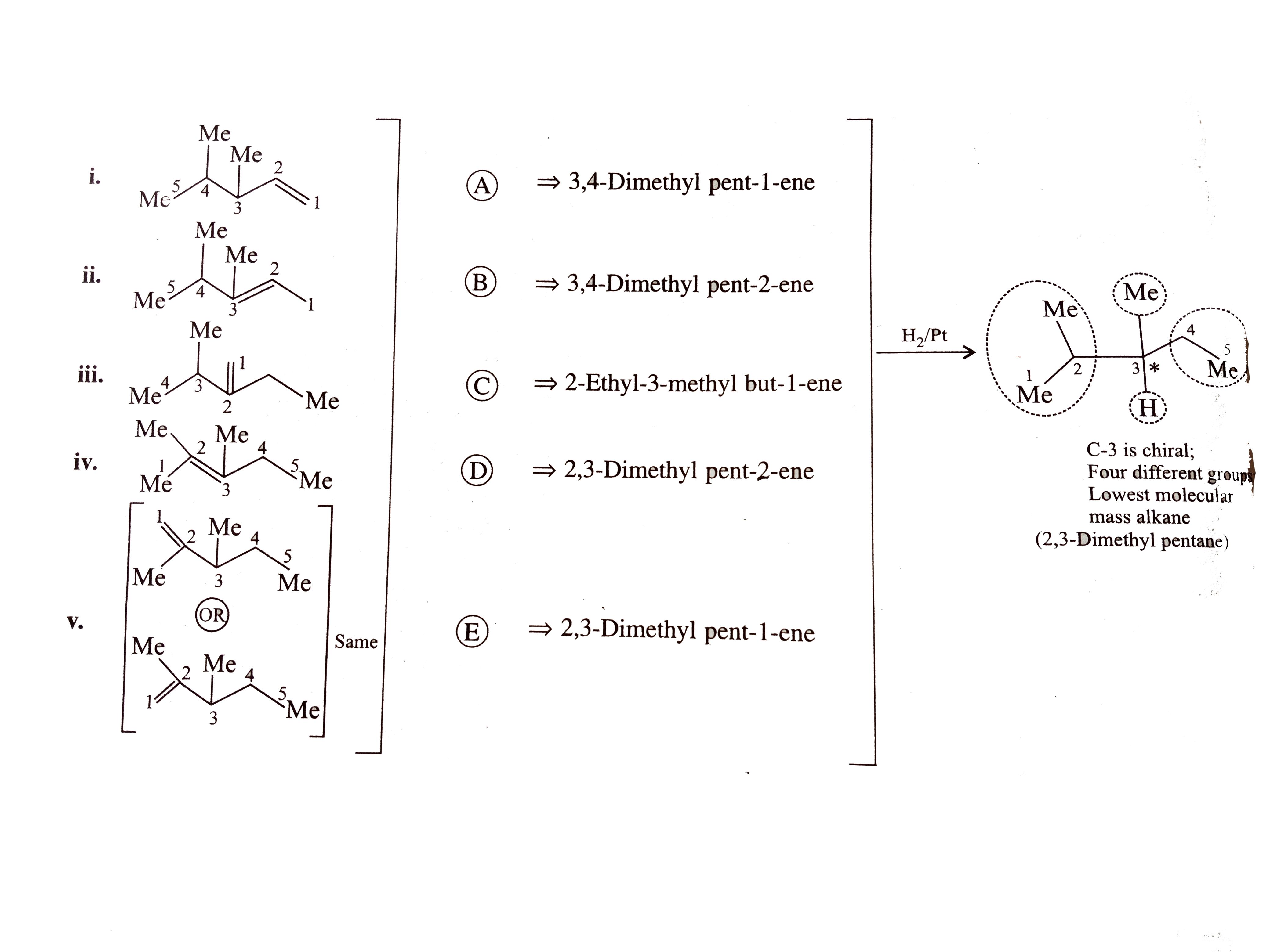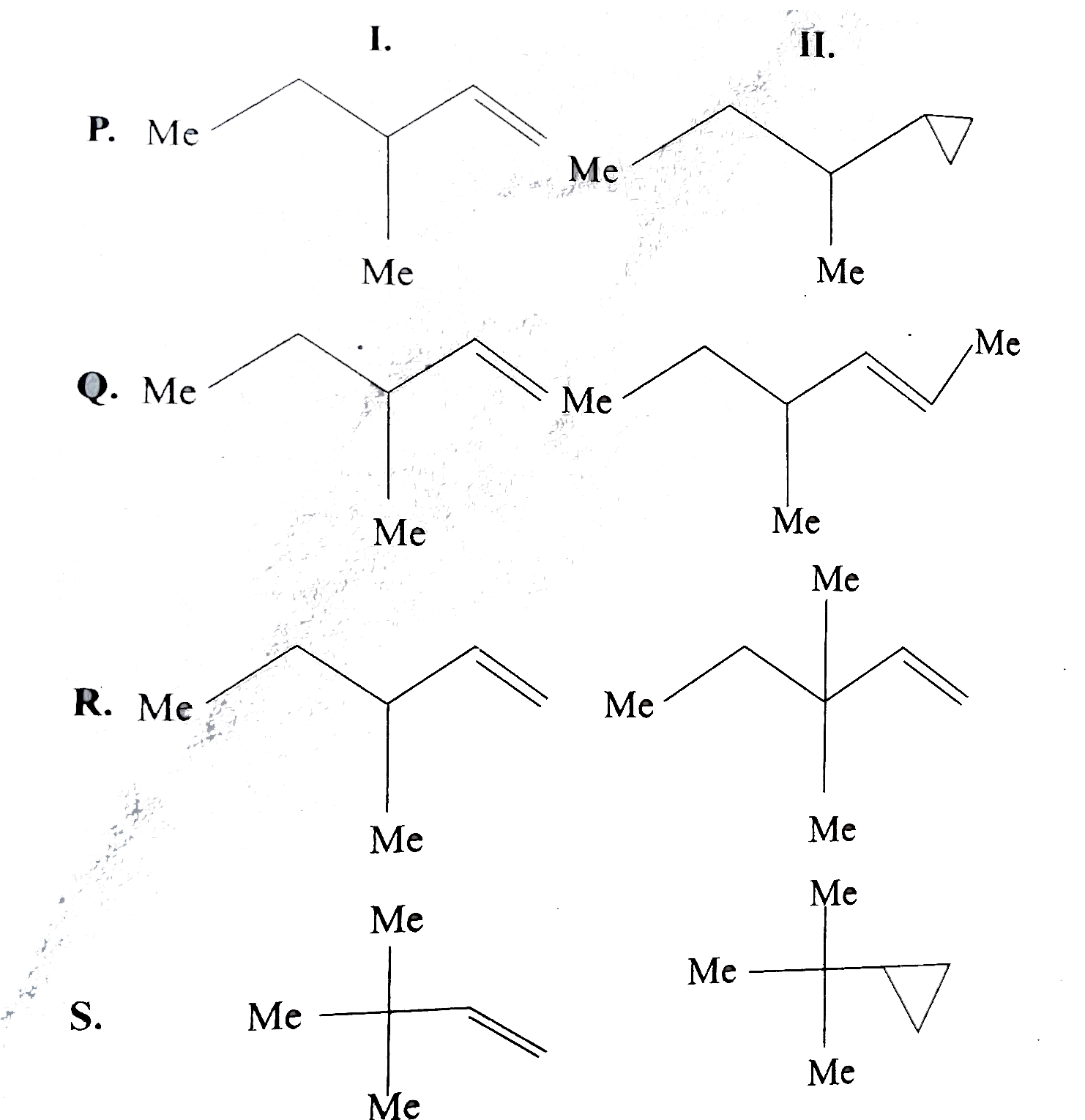There are five isomeric alkenes (A, B, C, D, and E) that require 1 mol of H2 per mole of alkene for hydrogenation and give the same product (F) on hydrogenation. F is an alkane having the lowest molecular mass and is opticalar mass and is optically active. Write the structures of the compounds from A to F.
Proceed as in Q. No. 6. Compound (F) will be (II). Therefore, five isomeric alkenes are:

Topper's Solved these Questions
- ALKANES AND CYCLOALKANESBOOK - CENGAGE CHEMISTRY ENGLISHCHAPTER - ALKANES AND CYCLOALKANESEXERCISE - Paragraph for problem
24 Videos
- ALKANES AND CYCLOALKANESBOOK - CENGAGE CHEMISTRY ENGLISHCHAPTER - ALKANES AND CYCLOALKANESEXERCISE - True and False
1 Video
- ALKANES AND CYCLOALKANESBOOK - CENGAGE CHEMISTRY ENGLISHCHAPTER - ALKANES AND CYCLOALKANESEXERCISE - SOLVED EXAMPLES
19 Videos
- ALKENES AND ALKADIENESBOOK - CENGAGE CHEMISTRY ENGLISHCHAPTER - ALKENES AND ALKADIENESEXERCISE - Single correct Answer
14 Videos
Similar Questions
There are six isomeric alkenes (A, B, C, D, E, and F) that require 1 mol of H2 per mole of alkene for hydrogenation and give the same product (G) on hydrogenation. G is an alkane having the lowest molecular mass and is optically active. Write the structure of compounds from A to G.
View SolutionGive the structure of an optically active alkene (A) having the lowest molecular mass, which on catalytic hydrogenation gives an optically inactive compound (B).
View SolutionAn optically active alcohol A (C6H10O) absorbs 2 mol of hydrogen per mole of A upon catalytic hydrogenation and gives a product B. The compound B is resistant to oxidation by CrO3 and does not show any optical activity Deduce the structures of A and B.
View SolutionGive the structure of an optically active alkyne (A) having the lowest molecular mass, which on hydrogenation with Lindlard's catalyst and Birch reduction gives the same lowest molecular mass optically active alkene.
View SolutionAn organic compound E(C5H8) on hydrogenation gives compoundF(C5H12). Compound E on ozonolysis gives formaldehyde and 2-ketopropanal. Deduce the structure of compound E.
View SolutionWrite the IUPAC name of the compound (A) which is a 2-methy1 branched alkane having a molecular mass of 254. This compound is a sex-attractant and is isolated from female tiger moths.
View SolutionWhen H2 is added to two isomeric alkenes A and B having molecular formula C5H9Cl, A gives optically inactive compound while B gives a chiral compound. The two isomers are
View SolutionNo. of structural isomeric alkenes (molecular formula =C6H12) which all give n-hexane on hydrogenation in presence of metal
catalyst
View SolutionCarbene intermediates are produced by the photolysis of diazomethane (CH2N2) or kenene (CH2=C=O). They are also produced by the reaction of CHX3 with base or by Simmons-Smith reaction. There are two types of carbenes, singlet and triplet. They are so called due to their spin state.
An optically active alkene (I) with lowest molecular mass on hydrogenation gives optically inactive alkene, but on insertion of methylene carbene (:CH2) in (I), it gives optically active compound (II). The compounds (I) and (II) are :
 .
.
View Solutioni. 27.8gm mixture of alkyne and alkane (both containing same number of carbon atoms) is dissolved in 1000gm of benzene. The solution freezes at 2.45∘C (lower than that of benzene). Another 27.8gm mixture requires 0.6 mol of H2 for complete hydrogenation. Calculate the chemical formula of alkyne and alkane (Kf for C6H6=4.9).
ii. Alkyne on hydrogenation with H2+Pt gives the same alkane.
Alkyne does not react with ammoniacal AgNO3 solution. Give the structures of both alkyne and alkane.
View Solution
